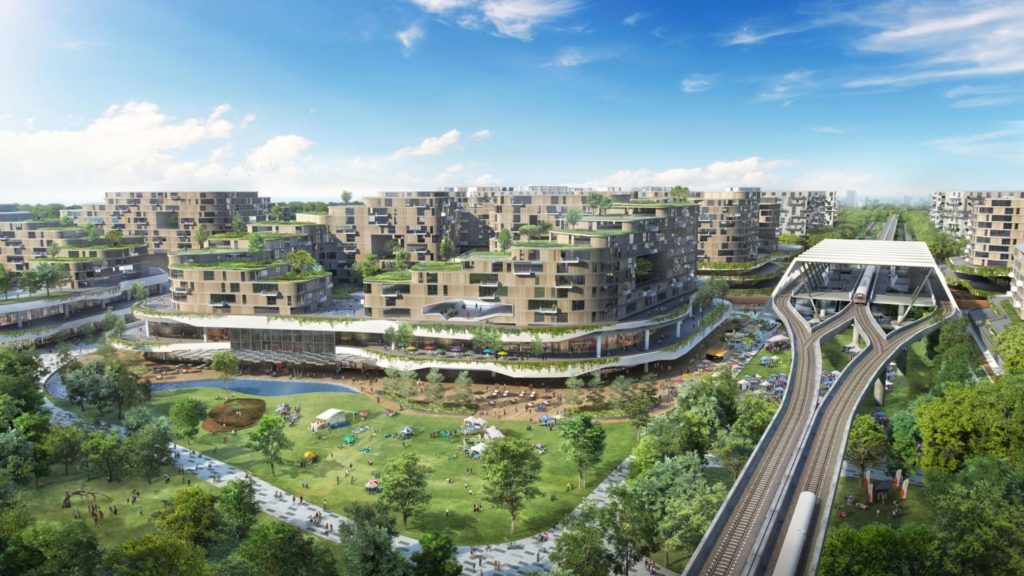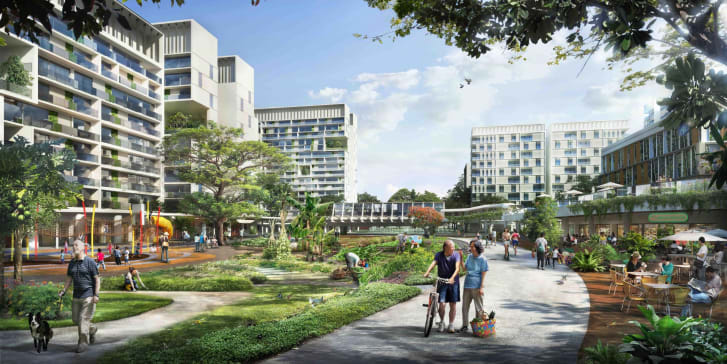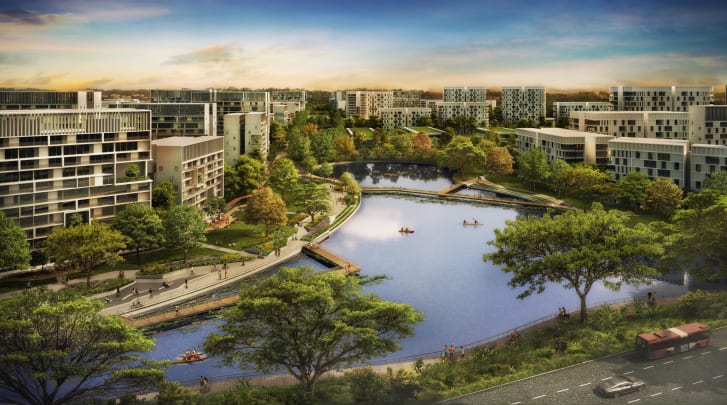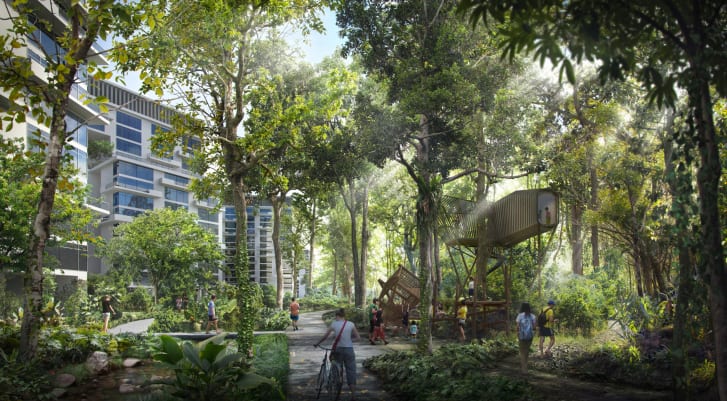80% of Singapore’s residents live in public housing and it’s a tropical country where convenience and air conditioning are a way of life. So there is a great opportunity for the government to influence new, more ecological development.
They are promising 42,000 new homes across five residential districts, and the eco-town of Tengah will be the 24th new settlement built by Singapore’s government since World War II. Tengah will be the first town with centralized cooling, automated trash collection and a car-free town center. 

The development is being dubbed a “forest town” by officials, due to its abundant greenery and public gardens. The 2.7-square-mile site has been reclaimed by an extensive secondary forest in recent years. A 328-foot-wide ecological “corridor” will be maintained through its center, providing safe passage to wildlife and connecting a water catchment area on one side to a nature reserve on the other.
Chong Fook Loong, group director for research and planning on the project, says, “Tengah is a clean slate; we’re going for the ideal concept of segregation of traffic, with everything underground and then the ground level totally freed up for pedestrians — for people. So, it’s a very safe environment for all. We want a town that allows walking and cycling in a very user-friendly manner.” The master plan will see the installation of electric vehicle charging stations and they are envisaging a future where autonomous vehicles and self-driving vehicles will become a reality.  With a population of under 6 million people, Singapore’s per-capita emissions are higher than those of the UK, China and neighboring Malaysia. That’s due, in part, to air conditioning, which accounts for more than a third of typical household energy consumption. Global warming will only exacerbate this dependence. They predict that, by the end of this century, average daily temperatures in the city-state may be at least 93.4 degrees Fahrenheit “almost every day” during the eight warmest months of the year!
With a population of under 6 million people, Singapore’s per-capita emissions are higher than those of the UK, China and neighboring Malaysia. That’s due, in part, to air conditioning, which accounts for more than a third of typical household energy consumption. Global warming will only exacerbate this dependence. They predict that, by the end of this century, average daily temperatures in the city-state may be at least 93.4 degrees Fahrenheit “almost every day” during the eight warmest months of the year!
 With a population of under 6 million people, Singapore’s per-capita emissions are higher than those of the UK, China and neighboring Malaysia. That’s due, in part, to air conditioning, which accounts for more than a third of typical household energy consumption. Global warming will only exacerbate this dependence. They predict that, by the end of this century, average daily temperatures in the city-state may be at least 93.4 degrees Fahrenheit “almost every day” during the eight warmest months of the year!
With a population of under 6 million people, Singapore’s per-capita emissions are higher than those of the UK, China and neighboring Malaysia. That’s due, in part, to air conditioning, which accounts for more than a third of typical household energy consumption. Global warming will only exacerbate this dependence. They predict that, by the end of this century, average daily temperatures in the city-state may be at least 93.4 degrees Fahrenheit “almost every day” during the eight warmest months of the year!Cold water, chilled using solar power, will be piped though the district’s homes, meaning residents don’t need to install inefficient outdoor AC condensers (though they can still control the temperature in their own apartments). This will generate carbon dioxide savings equivalent to taking 4,500 cars off the roads each year. Of the apartments already sold in advance, 9 out of 10 future residents have signed up for centralized cooling. Planners used computer modeling to simulate wind flow and heat gain across the town, helping to reduce the so-called urban heat island effect. 

“Smart” lights will switch off when public spaces are unoccupied, and trash will be stored centrally, with monitors detecting when garbage needs collecting. “Instead of using a truck to collect garbage from every block, we will suck all the garbage through the pneumatic system to a chamber that serves several blocks,” Chong said. “From time to time, the (garbage) truck just needs to collect from the chamber.”
Of the 42,000 homes being built at Tengah, more than 70% will be made available on long-term leases. Prices for two-bedroom apartments currently begin at just 108,000 Singapore dollars ($82,000), with the first apartments set to complete in 2023. 

All residents will have access to an app allowing them to monitor their energy and water usage. Digital displays in each block will meanwhile inform occupants of their collective environmental impact, which could even encourage competition between residential blocks. In addition to the aforementioned forest corridor, the town’s residents will have access to community farming in the so-called Plantation District.
The Nature Society of Singapore has criticized the plan for conserving too little — less than 10% — of the site’s existing forest. The environmental group has proposed two additional “core forest areas” at either end of the green corridor to promote biodiversity and protect migratory species. But even Tengah’s critics have broadly welcomed the eco-town, with the NSS concluding its environmental critique by stating it is still “heartened by this bold plan.”
You can read the original article at www.cnn.com
